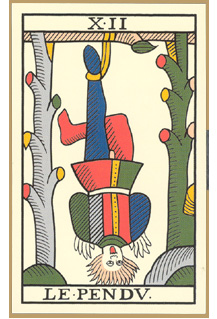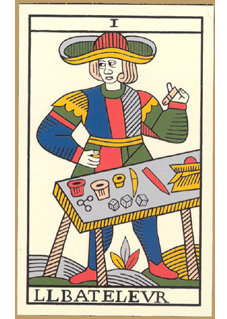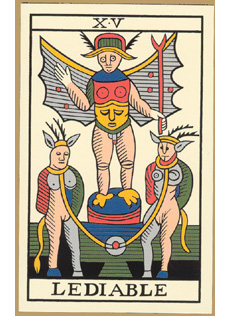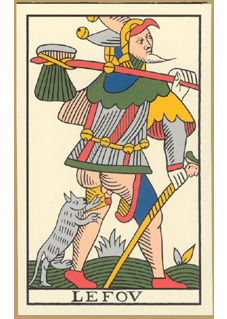|
 The Marseilles tarot pattern was derived from the earliest printed tarots and manifested as a
standard pattern in the beginning of the 18th century. It got its name when a large number of
card makers around Marseille adopted it for their productions, but it was also manufactured in several
other towns in France and in Switzerland and Italy. Several of the early Marseille tarots have
survived and have been reprinted in modern times for the benefit of card historians and collectors.
From time to time ancient Marseilles patterns were attempted "improved" or "rectified" by well-meaning
persons, like when Paul Marteau of Grimaud in 1930 presented a reconstructed and recolored
"Tarot de Marseille". This Grimaud edition is widely known today and by many considered being the
"true Tarot de Marseilles". Marteau's version was, however, actually not based upon an early Marseilles
pattern, but on a Besancon-pattern, printed by the Parisian card maker Arnoult about 1750. In 1997
Philippe Camoin of the Camoin family, card makers since the 18th century, produced together with
Alexandre Jodorowsky another so-called "restoration". By overlaying images and colors from various
early Marseilles decks and cultivating this information on a computer, they created a deck with a
rather artificial looking color setting , which they claimed was an "original Tarot de Marseilles".
A commercial promotion, followed up with tarot workshops and other arrangements in luxury surroundings
was, however, not successful. To bring life back to old decks is not an easy task.
The Marseilles tarot pattern was derived from the earliest printed tarots and manifested as a
standard pattern in the beginning of the 18th century. It got its name when a large number of
card makers around Marseille adopted it for their productions, but it was also manufactured in several
other towns in France and in Switzerland and Italy. Several of the early Marseille tarots have
survived and have been reprinted in modern times for the benefit of card historians and collectors.
From time to time ancient Marseilles patterns were attempted "improved" or "rectified" by well-meaning
persons, like when Paul Marteau of Grimaud in 1930 presented a reconstructed and recolored
"Tarot de Marseille". This Grimaud edition is widely known today and by many considered being the
"true Tarot de Marseilles". Marteau's version was, however, actually not based upon an early Marseilles
pattern, but on a Besancon-pattern, printed by the Parisian card maker Arnoult about 1750. In 1997
Philippe Camoin of the Camoin family, card makers since the 18th century, produced together with
Alexandre Jodorowsky another so-called "restoration". By overlaying images and colors from various
early Marseilles decks and cultivating this information on a computer, they created a deck with a
rather artificial looking color setting , which they claimed was an "original Tarot de Marseilles".
A commercial promotion, followed up with tarot workshops and other arrangements in luxury surroundings
was, however, not successful. To bring life back to old decks is not an easy task.
 The oldest known deck of the Marseilles-family was made in about 1650 by Jean Noblet in Paris and the
only existing copy is kept in the collection of Bibliothèque Nationale in Paris. The French artist,
Jean-Claude Flornoy has worked with the Marseille patterns for 20 years and has worked hard to get as
close as possible to the origin. To get the right feeling of the images and their details, he painted
more than two meter high enlargements of several of the cards (these paintings serve now as settings
at various tarot events). In 1996 Flornoy restored the Nicolas Conver deck (Marseilles 1760) and he
also produced handmade trump (major arcana) sets of the tarots of Jean Noblet and Jean Dodal
(Lyon 1701). Flornoy used stencils made on the basis of high resolution scans of the original decks to
restore the line art and add colors as true as possible to the images. For the Noblet deck, as many as
six different colors were applied to the sheet. This method is, of course, very time consuming and
costly, which resulted in the hand made sets encompassing the 22 trump cards only.
The oldest known deck of the Marseilles-family was made in about 1650 by Jean Noblet in Paris and the
only existing copy is kept in the collection of Bibliothèque Nationale in Paris. The French artist,
Jean-Claude Flornoy has worked with the Marseille patterns for 20 years and has worked hard to get as
close as possible to the origin. To get the right feeling of the images and their details, he painted
more than two meter high enlargements of several of the cards (these paintings serve now as settings
at various tarot events). In 1996 Flornoy restored the Nicolas Conver deck (Marseilles 1760) and he
also produced handmade trump (major arcana) sets of the tarots of Jean Noblet and Jean Dodal
(Lyon 1701). Flornoy used stencils made on the basis of high resolution scans of the original decks to
restore the line art and add colors as true as possible to the images. For the Noblet deck, as many as
six different colors were applied to the sheet. This method is, of course, very time consuming and
costly, which resulted in the hand made sets encompassing the 22 trump cards only.
 Now, for the first time since the original was printed in the mid-17th century, Flornoy has made
available to us a complete printed 78 card Noblet-deck. The surviving pack in the Bibliothèque
Nationale is missing five cards, the sword suit from 6 to 10, but luckily they were all number cards,
which could be restored without big problems. The printing is perfect and the color rendition is,
compared to Flornoy's limited stenciled majors as close as it can be. The main difference of the two
remakes is, that the black line art is thinner in the printed version. I find Flornoy's Noblet remake
amazing with its vivid colors and wealth of details. We do not know how the original color was
exactly. Decks of that age have, of course, faded through the ages, but the Flornoy version appears to
be credible. It is amazing how a variety of facial expressions, not only of the human characters, but
of the depicted animals, could be rendered with a few lines only. Another detail to notice is, that
350 years ago there was no repressed sexuality; they were free people and women exposed their nipples
and men their genitals. Just take, for example, a look at Noblet's Fool attacked by the animal, whatever
animal that is. Or look at the Magician. What kind of staff has he in his left hand? The Hanged Man
is sticking his tongue out and Justice's face depicts all kinds of neutrality. Despite its immediate
simplicity, there is certainly a lot of details to explore in the Noblet Tarot. Get a copy, compare it
to Grimaud's Tarot Marseille or any other Marseille types you have! You will enjoy it. The cards are
relatively small, 61 x 98 millimeters. They are stored in an agreeable cardboard box and accompanied
by a 64 page booklet of the same size as the cards.
Now, for the first time since the original was printed in the mid-17th century, Flornoy has made
available to us a complete printed 78 card Noblet-deck. The surviving pack in the Bibliothèque
Nationale is missing five cards, the sword suit from 6 to 10, but luckily they were all number cards,
which could be restored without big problems. The printing is perfect and the color rendition is,
compared to Flornoy's limited stenciled majors as close as it can be. The main difference of the two
remakes is, that the black line art is thinner in the printed version. I find Flornoy's Noblet remake
amazing with its vivid colors and wealth of details. We do not know how the original color was
exactly. Decks of that age have, of course, faded through the ages, but the Flornoy version appears to
be credible. It is amazing how a variety of facial expressions, not only of the human characters, but
of the depicted animals, could be rendered with a few lines only. Another detail to notice is, that
350 years ago there was no repressed sexuality; they were free people and women exposed their nipples
and men their genitals. Just take, for example, a look at Noblet's Fool attacked by the animal, whatever
animal that is. Or look at the Magician. What kind of staff has he in his left hand? The Hanged Man
is sticking his tongue out and Justice's face depicts all kinds of neutrality. Despite its immediate
simplicity, there is certainly a lot of details to explore in the Noblet Tarot. Get a copy, compare it
to Grimaud's Tarot Marseille or any other Marseille types you have! You will enjoy it. The cards are
relatively small, 61 x 98 millimeters. They are stored in an agreeable cardboard box and accompanied
by a 64 page booklet of the same size as the cards.


|